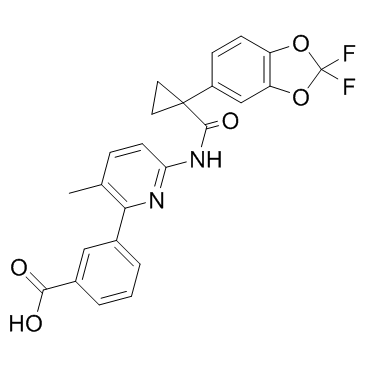Lumacaftor (VX-809)
Modify Date: 2025-08-22 04:43:54

Lumacaftor (VX-809) structure
|
Common Name | Lumacaftor (VX-809) | ||
|---|---|---|---|---|
| CAS Number | 936727-05-8 | Molecular Weight | 452.407 | |
| Density | 1.5±0.1 g/cm3 | Boiling Point | 653.0±55.0 °C at 760 mmHg | |
| Molecular Formula | C24H18F2N2O5 | Melting Point | N/A | |
| MSDS | N/A | Flash Point | 348.7±31.5 °C | |
Use of Lumacaftor (VX-809)Lumacaftor (VX-809) is a CFTR modulator that corrects the folding and trafficking of CFTR protein. |
| Name | 3-[6-[[1-(2,2-difluoro-1,3-benzodioxol-5-yl)cyclopropanecarbonyl]amino]-3-methylpyridin-2-yl]benzoic acid |
|---|---|
| Synonym | More Synonyms |
| Description | Lumacaftor (VX-809) is a CFTR modulator that corrects the folding and trafficking of CFTR protein. |
|---|---|
| Related Catalog | |
| Target |
EC50: 0.1 μM (CFTR)[1] |
| In Vitro | In fischer rat thyroid (FRT) cells, Lumacaftor improves F508del-CFTR maturation by 7.1±0.3 fold (n=3) compared with vehicle-treated cells (EC50, 0.1±0.1 μM; n=3) and enhances F508del-CFTR-mediated chloride transport by approximately fivefold (EC50, 0.5±0.1 μM; n=3). At Lumacaftor concentrations greater than 10 μM, the response is reduced, resulting in a bell-shaped dose-response relationship with an IC50 of approximately 100 μM. Lumacaftor is orally bioavailable in rats and achieved in vivo plasma levels significantly above concentrations required for in vitro efficacy[1]. Lumacaftor produces a concentration-dependent increase in the HRP luminescence signal after incubation with cells at 37°C or 27°C in both cell lines, with a similar EC50 value of approximately 0.3 µM. In F508-HRP CFBE41o- cells at 37°C, Lumacaftor increases the signal maximally to approximately 250 luminescence arbitrary units (a.u.) over the DMSO control baseline of approximately 60 a.u., representing an approximately 4-fold signal increase. Similarly, with the R1070W-HRP CFBE41o- cells, Lumacaftor increases the signal maximally to approximately 220 a.u. over the DMSO control baseline of approximately 85 a.u., representing an approximately 2.5-fold signal increase. Therefore, both cell lines produced robust signals with a good dynamic range for high-throughput screening[2]. |
| In Vivo | Oral dosing of 1 mg/kg Lumacaftor in male Sprague-Dawley rats results in a Cmax of 2.4±1.3 μM with a t1/2 of 7.7±0.4 h (mean±SD; n=3), indicating that that Lumacaftor is orally bioavailable and able to reach plasma levels that significantly exceeded EC50s for F508del-CFTR correction[1]. |
| Kinase Assay | Screening is carried out using a Beckman Coulter Biomek FX platform. In one set of assays, R1070W-F508-CFTR-HRP (R1070W-HRP)-expressing CFBE41o- cells are incubated with 100 µL medium containing 25 µM test compounds and 0.5 μg/mL Doxycycline for 24 hours at 37°C. In a second set of assays, F508-CFTR-HRP (F508-HRP)-expressing CFBE41o- cells are incubated with 100 µL medium containing 25 µM test compounds, 2 µM Lumacaftor, and 0.5 μg/mL doxycycline for 24 hours at 37°C. All compound plates contain negative controls (DMSO) and positive controls (2 µM Lumacaftor). In both assays, the cells are washed four times with PBS, and HRP activity is assayed by the addition of 50 µL/well of HRP substrate. After shaking for 5 minutes, chemiluminescence is measured using a Tecan Infinite M1000 plate reader equipped with an automated stacker (integration time, 100 milliseconds)[2]. |
| Cell Assay | .A549 cells expressing F508-CFTR YFP are grown at 37°C/5% CO2 for 18-24 hours after plating. The cells are then incubated with 100 μL of medium containing test compounds for 18-24 hours. At the time of the assay, cells are washed with PBS and then incubated for 10 minutes with PBS containing forskolin (20 μM) and genistein (50 μM). Each well is assayed individually for I- influx by recording fluorescence continuously (200 milliseconds per point) for 2 seconds (baseline) and then for 12 seconds after rapid addition of 165 μL PBS in which 137 mM Cl- is replaced by I-. The initial I- influx rate is computed by fitting the final 11.5 seconds of the data to an exponential for extrapolation of initial slope, which is normalized for background-subtracted initial fluorescence. All compound plates contain negative controls (DMSO vehicle) and positive controls (5 µM Lumacaftor). Fluorescence is measured using a Tecan Infinite M1000 plate reader equipped with a dual syringe pump (excitation/emission 500/535 nm)[2]. |
| Animal Admin | Rats[1] Male rats (n=3 per dose group) are orally administered Lumacaftor in a vehicle consisting of 0.5% Tween80/0.5% methylcellulose/water at a dose volume of 5 mL/kg. The concentration of Lumacaftor in plasma samples is determined with a liquid chromatography/tandem MS method. Pharmacokinetic parameters are calculated byusing WinNonlin Professional Edition software. |
| References |
| Density | 1.5±0.1 g/cm3 |
|---|---|
| Boiling Point | 653.0±55.0 °C at 760 mmHg |
| Molecular Formula | C24H18F2N2O5 |
| Molecular Weight | 452.407 |
| Flash Point | 348.7±31.5 °C |
| Exact Mass | 452.118378 |
| PSA | 97.75000 |
| LogP | 5.77 |
| Vapour Pressure | 0.0±2.1 mmHg at 25°C |
| Index of Refraction | 1.670 |
| InChIKey | UFSKUSARDNFIRC-UHFFFAOYSA-N |
| SMILES | Cc1ccc(NC(=O)C2(c3ccc4c(c3)OC(F)(F)O4)CC2)nc1-c1cccc(C(=O)O)c1 |
| 3-[6-({[1-(2,2-difluoro-1,3-benzodioxol-5-yl)cyclopropyl]carbonyl}amino)-3- methylpyridin-2-yl]benzoic acid |
| VX-809 (Lumacaftor) |
| 3-(6-{[1-(2,2-Difluoro-benzo[1,3]dioxol-5-yl)-cyclopropanecarbonyl]-amino}-3-methyl-pyridin-2-yl)-benzoic acid |
| MFCD16659051 |
| benzoic acid, 3-[6-[[[1-(2,2-difluoro-1,3-benzodioxol-5-yl)cyclopropyl]carbonyl]amino]-3-methyl-2-pyridinyl]- |
| 3-[6-({[1-(2,2-Difluoro-1,3-benzodioxol-5-yl)cyclopropyl]carbonyl}amino)-3-methylpyridin-2-yl]benzoic acid |
| Lumacaftor |
| 3-[6-({[1-(2,2-Difluoro-1,3-benzodioxol-5-yl)cyclopropyl]carbonyl}amino)-3-methyl-2-pyridinyl]benzoic acid |
| Lumacaftorum |
| UNII-EGP8L81APK |
| 3-(6-(1-(2,2-Difluorobenzo[d][1,3]dioxol-5-yl)cyclopropanecarboxamido)-3-methylpyridin-2-yl)benzoic acid |
| VX-809 |
| VX809 |
| 3-[6-[[[1-(2,2-Difluoro-1,3-benzodioxol-5-yl)cyclopropyl]carbonyl]amino]-3-methyl-2-pyridinyl]benzoic acid |